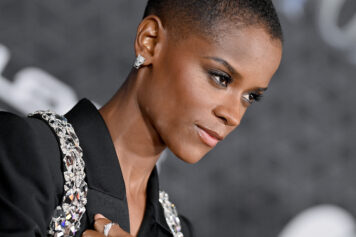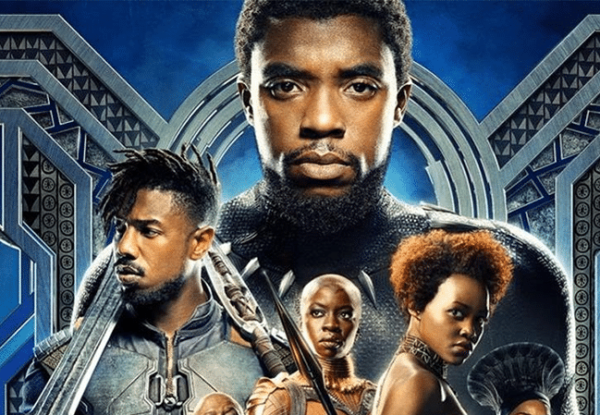
“Black Panther” has inspired many fans to wear African-inspired apparel to the theatre.
“Black Panther” opened Friday, Feb. 16 and spoiler alert a lot went down in the film. From the dynamic between T’Challa/Black Panther and forgotten Wakandan Erik Kilmonger to the covert technology embedded in the fictional African nation, there are many things Atlanta Black Star got out of the flick. Below are four things we loved — and three things we hated about “Black Panther.”
What We Loved

(Marvel)
Diverse Roles of Wakandan Women
The most obvious example is the Dora Milaje, the special guards of the Black Panther who protect the throne and the royal family. The depiction of these elite warriors is reminiscent of the Mino, an all-female military regiment existing between the 17th and 19th centuries in the West African Kingdom of Dahomey (present-day Benin). Additionally, T’Challa’s sister, Shuri’s genius-level mastery of science and technology along with Nakia’s philanthropy outside of her duties to Wakanda (and her relationship to T’Challa) depicted Black women in roles that expand beyond the usual Hollywood stereotypes.
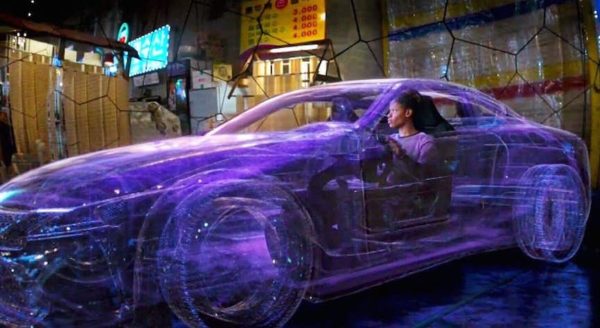
(Marvel)
Advanced Spiritual and Technological Capabilities
The Black Panther story has Wakanda being the most technologically advanced country in the world. From the Vibranium suits that absorbs and stores kinetic energy to the VR technology that allows Shuri to remotely operate a car from thousands of miles away, the tech is certainly out of this world.
However, there are legends about the capability within traditional African spiritual systems to use rituals to harness spiritual powers to gain supernatural abilities. This notion was captured in the movie through the concept of the Heart-Shaped Herb, which T’Challa and Kilmonger consumed to obtain their super-human powers. In the film, T’Challa is seen twice being stripped of his Black Panther powers through a ritualistic ceremony to make it a fair fight when he has challengers for the throne. He regains his powers only after taking the herb that allows him to communicate with his ancestors.
The Traditional-Inspired Afrocentric Costumes
Traditional African dress is varied and diverse and this was reflected in the futuristic depictions of Wakandan citizens. Black Panther costumes took inspiration from an array of ethnic dress found across Africa. Costume designer Ruth Carter told SyFy the Dora Milaje’s costumes were “patterned after the Masai of Kenya, you know that red and the beadwork, but also their neckwear. The golden collars were reminiscent of the Ndebele women.” Other style influences from the motherland came from the Dogon, Toureg, Akan, and Mursi peoples. The costumes used in slavery and Jim Crow-era films could never be as uplifting as the regal and eye-catching wears portrayed in the record-breaking movie.
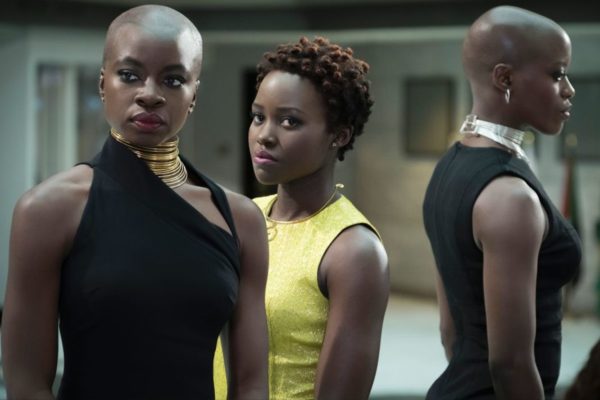
(Marvel)
Natural Hairstyles Embracing Kinks and Coils
For many Black women, hair is not a trivial thing, it is something that is laden with messages, and in a straight-hair, biased world it determines how others treat you, and in turn, how you feel about yourself. So it’s not surprising that the movie touched on the subject. It’s clear in the film that the women of Wakanda are free from pressure to conform to strait-hair bias. They are portrayed as beautiful in all their glory donning many of the natural styles seen today like Nyong’o’s Nakia’s signature “Wakanda Knot,” as hair department head Camille Friend described it to BET. “We did a totally Afrocentric, natural hair movie,” Ms. Friend said. “There was not a pressing comb or relaxer on set.
One of the most memorable hair moments of the film was where Dora Milaje head Okoye wears a straight-haired bob wig as a disguise for her undercover mission in South Korea. Disgusted by the head piece she tosses it the first opportunity she gets to sport her more comfortable bald look. Okoye’s wig scene subtly represents a rejection of the notion that straight hair is somehow preferable to kinks or curls or even a bald head.
What We Hated
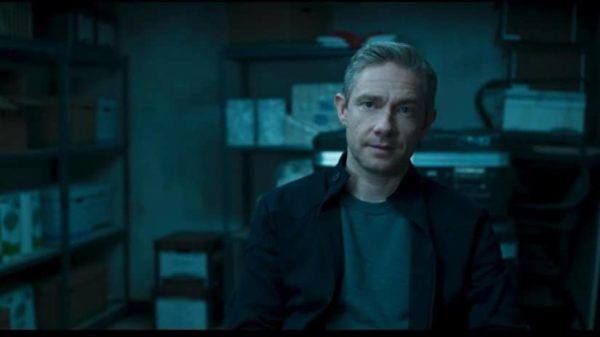
(Marvel)
Saving White CIA Operative and Letting Him Into Wakanda
When CIA Operative Everett Ross is shot during Black Panther’s mission in South Korea, he is taken back to Wakanda so Vibranium can be used to save his life. While in the reclusive African nation, Ross winds up being one of the most significant heroes of the movie by remotely flying the aircraft used to shoot down the planes attempting to export Vibranium to other parts of the world.
Hollywood is so obsessed with the “White Savior” concept, it could not be excluded from a film that is supposedly portraying an African nation that practices self-determination. Instead of making the Wakandans the sole determining factor of their destiny, Ross becomes another visual representation of the “White Man’s Burden,” reinforcing the same colonial message that Black people need white people to save them – a blatant contradiction to what Wakanda is supposed to represent.
African-American Homecoming Villanized
As decedents of enslaved Africans, it’s common to hear discouraging objections to fraternizing with Africans from the continent or returning to the continent to visit or live. “Those Africans over there don’t like us,” is the usual reason touted today. At the same time, Africans on the continent are often warned about their trouble-making “lost” brothers and sisters in the West, who have forgotten their language and culture. In the film, Erik Kilmongers relationship to his Wakandan-born relatives represented this misunderstanding. Killmonger is the forgotten child of Wakanda, having been the son of King T’Chaka’s brother, Prince N’Jobu. Rather than being welcomed back with open arms, his Wakandan family rejects him, just as he had expected. He is portrayed as being a disruptive force to their traditions, and they as dismissive of his experience in America. Hence, the film not only misses an opportunity to help bridge the divide between Africans born on the continent and those born in the U.S., instead, it may have reinforced it.
Villainization of Pan-Africanism and Black Liberation
Killmonger came of age in 1990s Oakland, Calif., where poverty and police brutality ran rampant. His father, Prince N’Jobu was on a spying mission in America when he became disillusioned by Wakanda’s isolation policy. He wanted to use the Vibranium to help other Black people but was killed by his own brother to protect the secrets of the country.
Years later, when Killmonger arrives in Wakanda to finish what his father started, he is killed by T’Challa/Black Panther. It’s an extremely sympathetic position, yet the filmmakers were determined to make him as ruthless and inhumane as possible — he ruthlessly murders his own accomplices and he dethrones T’Challa, nearly killing him in the process.
The film encourages us to side with T’Challa, who wants to ignore the plight of other Black people in the world, and despise Killmonger, whose anti-colonial perspective is much closer to the actual historic Black heroes we honor and revere today like Nat Turner, Marcus Garvey, Malcolm X, Jomo Kenyatta, Steve Biko, and countless others. Killmonger’s death and that of his father was a symbolic assassination of the ideas of Black Liberation/Pan-Africanism.



